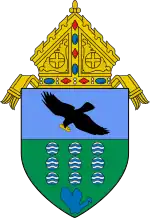| Paete Church | |
|---|---|
| The Roman Catholic Church of Saint James the Apostle | |
.jpg.webp) Church facade | |
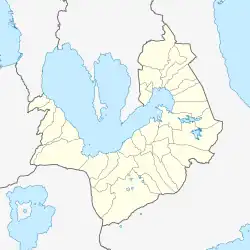 Paete Church .svg.png.webp) Paete Church .svg.png.webp) Paete Church | |
| 14°21′52″N 121°28′54″E / 14.364557°N 121.481638°E | |
| Location | Paete, Laguna |
| Country | Philippines |
| Denomination | Roman Catholic |
| Website | Diocese of San Pablo |
| History | |
| Former name(s) | Pueblo de San Lorenzo Diacono |
| Status | Parish church |
| Founded | 1580 |
| Founder(s) | Juan de Plasencia and Diego de Oropesa |
| Dedication | Saint James the Greater |
| Architecture | |
| Functional status | Active |
| Heritage designation | National Historical Landmark |
| Architectural type | Church building |
| Style | Baroque Mission |
| Groundbreaking | 1864 |
| Specifications | |
| Length | 42 m (138 ft) |
| Width | 7 m (23 ft) |
| Height | 14 m (46 ft) |
| Materials | Adobe, egg white and other native material |
| Administration | |
| Province | Laguna |
| Archdiocese | Manila |
| Diocese | San Pablo |
| Clergy | |
| Priest(s) | Rex Maharlika P. delos Angeles |
| Assistant priest(s) | Ricky B. Velasco |
The Saint James the Apostle Parish Church, also known as The Roman Catholic Church of Saint James the Apostle or commonly known as Church of Paete, is the only Roman Catholic church in Paete, Laguna, Philippines. Its patron saint is James the Apostle and his feast is celebrated every 25 July. The church is known for its huge and exquisite collection of images depicting the Passion of Christ, its century-old paintings and wooden images of saints (or poon).
History

Paete was established as town in 1580 by Franciscan priest Fray Juan Plasencia under the patronage of Saint Lawrence.[1][2] Due to the scarcity of religious men, it was annexed to the visita of Lumban until October 20, 1600, and to Pangil until 1602.[1] The first parish priest of Paete, Fray Pedro de Buenaventura, was appointed in 1602.[1] The first stone church and convent were built by Paete natives under the supervision of Fray Andres de Puertellanoin 1646 but it was later destroyed by an earthquake in 1717.[2] A new stone church was started the same year under Fray Francisco de la Fuente.[2][3] It was completed in 1840 under the term of Fray Luis de Nambroca.[3] The church and convent was again destroyed by the 1880 Luzon earthquake.[2][4] Father Gregorio Martin built a temporary small church of 33 m (108 ft) by 13.2 m (43 ft) by 8.6 m (28 ft).[5] In 1884, the church was rebuilt under Father Pedro Galiano, now facing the Laguna lake but this was again destroyed by another earthquake on August 20, 1937.[2] The church served as a dungeon and torture house to the people of Paete during the Japanese occupation of the Philippines in World War II.
Features
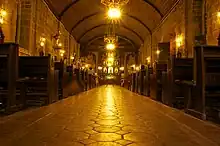
The church is 42 m (138 ft) long by 7 m (23 ft) thick by 42 m (138 ft) wide.[6] The church underwent a lot of renovation due to natural calamities. With a long history of losing the church building to earthquakes, the current baroque mission church has large buttresses on each side to improve its earthquake resistance.[7] It was made of adobe bricks, a mixture of egg white and other native materials. The church has an elaborate baroque style with a fusion of oriental artistry. The intricate retablo pieces were made by Paetenian natives, among them were Bartolome Palatino and Francisco Macahumpan.[8]
Façade
The church's facade is divided by a frieze that continues around the adjoining belltower. It has bas reliefs of leaves and flowers and a sculpted image of St. James depicted as a Santiago Matamoros (Saint James the Moor-slayer) in a central niche of the upper story. The relief of Saint James is no longer the original image. The present relief which replaced the original one was installed in 1804.[6] The triangular stepped pediment has a circular aperture directly above the image of St. James. Several arched windows decorate the bell tower.
Luciano Dans Murals
The large wall paintings on wood panels inside the church were executed by another notable son of Paete, Luciano Dans. These depict Langit, Lupa, Impiyerno - Heaven, Earth, Hell - and large murals of Saint Christopher. Dans used natural color pigments mixed with volcanic ash and brushes made from cats' hair to create the murals.[9] The large painting of San Cristobal on wood was purchased during the time of Father Francisco de Santa Gonzaleza for ₱22 in October 1852.[5] Unfortunately, the two St. Christopher paintings currently need immediate conservation.: a lot of wood panels inside the church, including the painted wood panels, are infested by termites.[10][11]
- Murals inside the Catholic Church of Paete
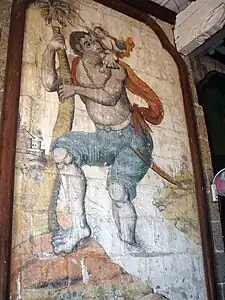
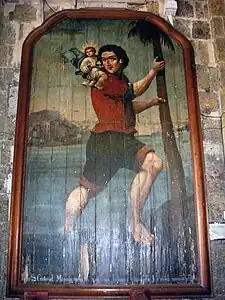
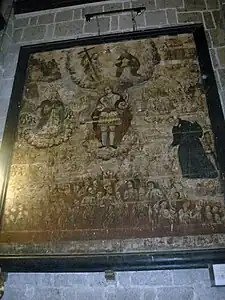
Another mural created by another unknown artist and the oldest among all murals inside the church is the Last Judgment or Juicio Final painted around 1720. It is located near the church altar.[12]
Church Traditions
Lenten and Holy Week Traditions
At the start of the Lenten season, owners of privately owned religious images that were handed down from generations put up an exhibit of their religious icons on the church's hall. The collection of images is one of the largest collection of images depicting the passion of Christ.[7] The exhibit usually ran from Ash Wednesday up to Holy Monday. On Holy Tuesday, a procession of miniature poon carried by children along the church patio. From Holy Wednesday up to Good Friday, locals processed their religious images around the town.
The most famous poon during the holy week celebration is Mariano Cagahastian Madriñan's replica of his own work of Mater Dolorosa. Madriñan, Paete's hero received a diploma of award and the King Alfonso XII of Spain Medal of Honor for his Mater Dolorosa work in 1882 which was exhibited at the International Exposition held in Amsterdam.[7] The image of the Mother of Sorrows was known for its movable parts with excellent articulation. During procession, the image could be made to embrace the statue of Christ carrying His cross, look up to gaze at St. Veronica's veil and bless her with the sign of the cross.[7] The image of St. Veronica could also move its hand to show the veil imprinted with Christ's face.
Salibanda
The celebration of Salibanda is celebrated every third week of January. It marks the end of the Christmas season in Paete and the feast of the Infant Jesus (or Santo Niño).[7] It starts with a fluvial parade along with an image of Santo Niño and followed by a dance procession to the church.
Feast of San Antonio Abad
The feast of San Antonio Abad, Paete's secondary patron is celebrated every January 17. A small stone chapel or ermita dedicated to the Saint Anthony is located near the main church.[3][7]
Notes
- 1 2 3 Huerta 1865, p. 138
- 1 2 3 4 5 National Historical Institute 1993, p. 85
- 1 2 3 Huerta 1865, p. 139
- ↑ "American Journal of Science - Art.V. The earthquake of the Philippine Islands, July 1880", pp.52–57.
- 1 2 Jose 1987, p. 102
- 1 2 Jose 1987, p. 94
- 1 2 3 4 5 6 Castillo-Pruden, Marie Cagahastian (December 21, 2000). "About Paete - More than a couple of streets". Retrieved July 1, 2014.
- ↑ "SAGIP SAN CRISTOBAL: HELP SAVE PAETE CATHOLIC CHURCH 19tH CENTURY MURALS". Retrieved October 14, 2015.
- ↑ Giron, Tita (March 20, 2005). "A scenic way to do the traditional 'Via Crucis'". Philippine Daily Inquirer.
- ↑ Dalisay, Butch (April 19, 2010). "Save the Paete murals". Philippine Star. Retrieved August 11, 2015.
- ↑ "KSP: Makasaysayang simbahan sa Paete, Laguna, napapabayaan na". ABS-CBN News. April 21, 2013. Retrieved August 11, 2014.
- ↑ Ocampo, Ambeth (March 5, 2014). "Treasure in Paete". Philippine Daily Inquirer. Retrieved August 11, 2014.
Bibliography
- Huerta, Felix de (1865). Estado geográfico, topográfico, estadístico, histórico religioso. Binondo: Imprenta de M. Sanchez y Ca.
- Historical Markers: Regions I-IV and CAR. Manila: National Historical Institute (Philippines). 1993. p. 85. ISBN 9715380611.
- Jose, Regalado Trota Jr. (1987). "The Church of Paete in 1807: Ecclesiastical Decorations and Furnishings". Philippine Studies. 35 (1): 93–102. – via JSTOR (subscription required)
External links
 Media related to Paete Church at Wikimedia Commons
Media related to Paete Church at Wikimedia Commons- The Roman Catholic Parish of Saint James the Apostle, Paete, Laguna (Official Facebook page)
